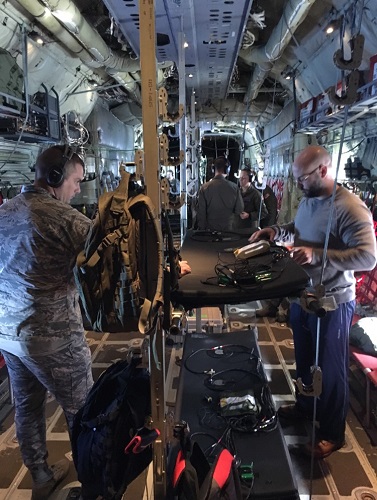
Keeping a pulse on advancing en route patient monitoring

The digital noise-immune stethoscope, currently being evaluated by researchers with the 711th Human Performance Wing at Wright-Patterson Air Force Base, Ohio, connects into existing headsets used by aeromedical evacuation crews and critical care air transport teams. Traditional stethoscopes are difficult to use during en route care due to an aircraft’s noise environment. This noise-immune stethoscope aims to address that issue. (U.S. Air Force photo by Brittany Fouts)
FALLS CHURCH, Va. — Researchers with the 711th Human Performance Wing at Wright-Patterson Air Force Base, Ohio, are evaluating prototype noise-immune stethoscope technologies to assess their ability to function in dynamic high-noise environments on aircraft.
“A traditional stethoscope is essentially useless during en route care because of the noise,” said Tamara Averett-Brauer, U.S. Air Force School of Aerospace Medicine research thrust area lead for aeromedical evacuation. “As we were working with this noise-immune stethoscope, we discovered many advantages to the device.”
According to Dr. David Burch, a research biomedical engineer and the medical technology solutions team lead for En Route Care Medical Technology Solutions Research Group, 711th HPW, using the noise-immune stethoscope during en route care can boost patient monitoring capabilities.

Dr. David Burch (right), a research biomedical engineer and the medical technology solutions team lead for En Route Care Medical Technology Solutions Research Group with the 711th Human Performance Wing at Wright-Patterson Air Force Base, Ohio, collects data on vibration profiles while flying aboard a C-130J Super Hercules. (Courtesy photo)
“A stethoscope is a common piece of equipment, but in the air it is almost unheard of. Having this type of technology will improve a provider’s assessment capabilities,” said Burch.
Averett-Brauer explains, this stethoscope looks and feels more like a traditional stethoscope head. To operate in challenging noise environments, the noise-immune stethoscope would plug into existing headsets AE crews and critical care air transport teams already wear.
“It’s a simple and relatively inexpensive device,” said Averett-Brauer. “While it’s commercially available, operational evaluations still have to be done to ensure it will function in the AE environment.”
Air Force researchers are working with the Airman Systems Directorate, also part of the 711th HPW, in evaluating and tailoring the noise-immune stethoscope. As Burch explains, this brings together technical capabilities from the ASD and the medical expertise across the Wing.
“We have to work with the constraints of the aircraft, as well as communication and policy restraints,” said Averett-Brauer. “Whenever we are working with medical devices like the noise-immune stethoscope, we know that the technology is possible, but we have to work through some of these rules and communication frequencies before putting it onto the aircraft.”
Researchers are in the process of collecting data to characterize the noise profiles of different aircraft, while also working with the private company who developed the stethoscope to adjust its capabilities.
“It’s a unique design challenge since every aircraft an AE crew will potentially be on has a different noise profile, and we want it to work across all platforms,” said Burch. “It has driven an effort to investigate the characteristics that will influence the design for these active noise filters. We have to work with the company to tailor the design of those filters to meet the needs for patient care as well as communications.”
While it is currently in the evaluation phase, researchers know how valuable a device like the noise-immune stethoscope is to patient care.
“We don’t want to keep the status quo, we want to improve patient outcomes,” said Burch. “We want to avoid any type of degradation of that Trusted Care our warfighters have continued to experience. This technology and the effort behind it will ultimately be advantageous for Air Force medicine and en route patient care.”
Disclaimer: Re-published content may have been edited for length and clarity. Read original post.





















.png)









No hay comentarios:
Publicar un comentario